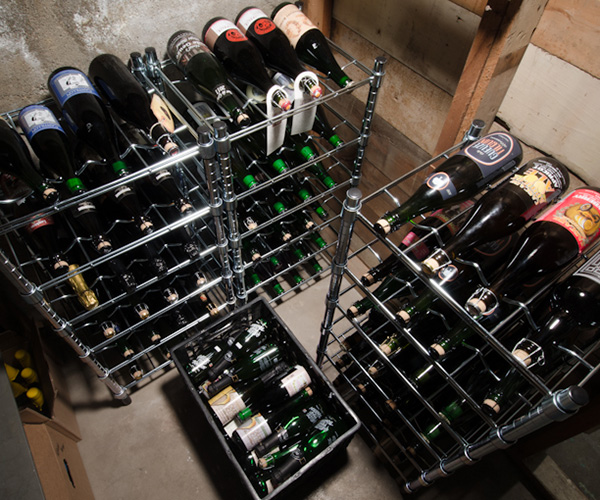Beer is often referred to as liquid bread—an apt description for our favorite beverage. Craft beer has similar ingredients, flavors and aromas to bread, and like bread, is generally best to enjoy fresh. Yes, some beers can improve with age, but cellaring beer provides no guarantee that the beer will be any better than when it was fresh.
True, the volatile compounds, like hop aroma, that make up flavors and aromas change when beer is aged. The same way an aged bottle of wine will exhibit different flavors after cellaring. This is all perfectly fine if you like the character of aged wine, but if you don’t, why the heck did you save it? The same idea is correct with beer.
Craft Brewers Strive for Freshness
The vast majority of beer styles are meant to be enjoyed fresh. Certain beers can develop positively over time—check out the list of common cellaring developments down below.
Grand Teton’s Rob Mullin talked about which of their beers improve with age in “Cellar Notes: Sitting Atop Grand Teton (Beers)Opens in new window,” but Mullin also points out that “great efforts are taken to keep our products fresh in all our markets.”
It wasn’t long ago that many so-called beer authorities touted highly hopped beers, like Imperial IPAs, as beers suitable for aging. Luckily for us, breweries like Russian River Brewing Co.Opens in new window have taught us that age is the last thing they want for beers like Pliny the Elder and Blind Pig. Opens in new window
Russian River even educates beer retailers to not wait to tap the uber-limited Pliny the Younger, as it is meant to be experienced as fresh as possible. “We want you to enjoy Younger from the source at its absolute best! Like all fresh food products, this beer has a very short ‘shelf’ life and is meant to be consumed only when in season…” RRBC explains.
Stone Brewing Co.Opens in new window also reminds us that hoppy beers are best fresh. The San Diego craft brewery’s Stone Enjoy by IPAOpens in new window gets craft beer geeks clamoring when it is released, not just because of its limited distribution, but also because the beer’s time sensitive nature.
We specifically brewed it not to last,” says Stone Brewing in their description of the beer. “We’ve not only gone to extensive lengths to ensure that you’re getting this beer in your hands within an extraordinarily short window, we made sure that the Enjoy By date isn’t randomly etched in tiny text somewhere on the label, to be overlooked by all but the most attentive of retailers and consumers. Instead, we’ve sent a clear message with the name of the beer itself that there is no better time than right now to enjoy this IPA.”
It’s obvious that Stone takes its out of date beer seriously, as they’ve set up an online formOpens in new window for beer fans to report any out of date Stone beer they come across in the marketplace so they can replace it as quickly as possible.
To Age or Not to Age?
That is the question! Like many beery things, cellaring is largely a personal journey, and a perfectly acceptable craft beer experience. Some breweries even aid prospective “cellar rats” (as they’re often lovingly referred to) by providing a “cellar up to” date, like Left Hand Brewing Company’sOpens in new window Widdershin Barleywine. In this case, the brewery recommends cellaring this oak-aged, peated-malt barley wine for up to five years. However, the label does not say you can’t or shouldn’t enjoy this beer fresh.
For those who enjoy cellaring, the gamble can pay off. Many cellared beer fans enjoy the complexity that proper aging can add to craft beers. Additionally, vintage bottles offer an opportunity to create new educational experiences with beers that are uniquely in the individual’s control. The key to cellaring is to control as many environmental factors as possible to ensure the beer is aging properly and not just getting old.
Creating the Ideal Cellaring Environment
- Beer style: Craft beers over 7 percent ABV with strong flavors (eg: smoked malt) tend to handle age better than others.
- Light: Ultraviolet light reacts with compounds in beer to develop the dreaded skunky character. Keep all beer in the dark.
- Temperature: Warmer temperatures speed up the effects of aging. Keep beers cool to cold, but don’t let them freeze.
- Movement: Agitation aides in the effects of oxidation and age. Set’em and forget’em.
I like this article that delves into the cellaring practice a bit deeper: “Cellarmanship Part 2: How To Store Your Hoarded Beer Properly.”
Cellaring’s Effects on Taste and Flavor
Aging can produce many changes in the flavors and tastes present in a beer. Here are some of effects you can expect, according to a presentation given by Dr. Charlie Bamforth, Tom Nielsen and Mitch Steele entitled “Keep It Fresh: Understanding How Time, Temperature and Oxygen Impact Your Beer, and What To Do About Them.”
- Bitterness decreases
- Harshness increases
- Fruity and floral esters decrease
- Ribes (catty/black currant character) increase
- Wet paper/cardboard character increases
- Bready character increases
- Sweetness (toffee/honey) increases
- Metallic character increases
- Earthy character increases
- Straw character increases
- Woody character increases
- Vinuous character (wine/sherry/stale fruit) increases
- Meaty-like/brothy flavors can develop
Choose Your Own Adventure
Think of craft beer as one of those Choose Your Own Adventure books you read as a kid. While aging beer is a fine adventure, you need to evaluate all of the potential outcomes. Will the beer improve with age? Maybe. Or you may end up with unfavorable results–like being eaten by sharks, which is probably why I never got into those books.
Bottom line: control the cellaring environment as much as possible and use discretion when choosing which craft beers to age.
Photos by Daniel Flanders at Focus on the Beer
CraftBeer.com is fully dedicated to small and independent U.S. breweries. We are published by the Brewers Association, the not-for-profit trade group dedicated to promoting and protecting America’s small and independent craft brewers. Stories and opinions shared on CraftBeer.com do not imply endorsement by or positions taken by the Brewers Association or its members.


Share Post